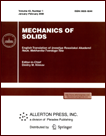 | | Mechanics of Solids
A Journal of Russian Academy of Sciences | | Founded
in January 1966
Issued 6 times a year
Print ISSN 0025-6544
Online ISSN 1934-7936 |
Archive of Issues
| Total articles in the database: | | 13362 |
| In Russian (Èçâ. ÐÀÍ. ÌÒÒ): | | 8178
|
| In English (Mech. Solids): | | 5184 |
|
| << Previous article | Volume 60, Issue 3 / 2025 | Next article >> |
| Xuejin Yan, Feng Xu, and Changqing Guo, "Forced Vibration of a Fluid-Conveying Pipe under the Combined Action of Rigid Constraint and Pasternak base," Mech. Solids. 60 (3), 2085-2099 (2025) |
| Year |
2025 |
Volume |
60 |
Number |
3 |
Pages |
2085-2099 |
| DOI |
10.1134/S0025654425600424 |
| Title |
Forced Vibration of a Fluid-Conveying Pipe under the Combined Action of Rigid Constraint and Pasternak base |
| Author(s) |
Xuejin Yan (School of Civil Engineering, University of South China, Hengyang, Hunan, 421001 China, 1141603477@qq.com)
Feng Xu (School of Mathematics and Physics, University of South China, Hengyang, Hunan, 421001 China, hsubong@usc.edu.cn)
Changqing Guo (School of Mathematics and Physics, University of South China, Hengyang, Hunan, 421001 China, GuoCQ@hotmail.com) |
| Abstract |
When the fluid-conveying pipe is buried on the surface of the base, it will not only suffer from rigid impact damage caused by base excitation and surrounding gravel, but also be affected by the characteristics of the base, which makes safety accidents extremely likely to occur during the operation of the fluid-conveying pipe. Based on the Hamilton principle, a mathematical model of simply supported fluid-conveying pipe structures with a rigid constraint on the Pasternak base under base excitation is established. The Galerkin method is used to discretize the equation of motion, and the NDFS algorithm is employed to solve the system of equations. The influence is discussed in terms of the base excitation frequency, internal flow rate, and the viscoelastic coefficient of the pipe on the model. Bifurcation diagrams, phase diagrams, Poincaré maps, and time-history curves under various parameters are used to analyze the impact vibration response of the fluid-conveying pipe system. The research shows that: grazing impact usually occurs when the system’s motion state changes under impact vibration, and at a lower base excitation frequency, grazing impact will induce incomplete chatter-impact vibration in the system; there is a particular dynamic law in the evolution between quasi-periodic motion and single-period non-impact vibration on the Poincaré map; the increase in the equivalent linear spring stiffness K and shear stiffness KG of the Pasternak base is beneficial for resisting the unstable factors caused by base excitation. The findings of this study provide theoretical support for the optimal design, operation maintenance, and safety assurance of fluid-conveying pipes on the Pasternak base. |
| Keywords |
fluid-conveying pipe, base excitation, impact vibration response, Pasternak base |
| Received |
24 January 2025 | Revised |
26 February 2025 | Accepted |
28 March 2025 |
| Link to Fulltext |
|
| << Previous article | Volume 60, Issue 3 / 2025 | Next article >> |
|
 If you find a misprint on a webpage, please help us correct it promptly - just highlight and press Ctrl+Enter If you find a misprint on a webpage, please help us correct it promptly - just highlight and press Ctrl+Enter
|
|

 Russian
Russian  English
English